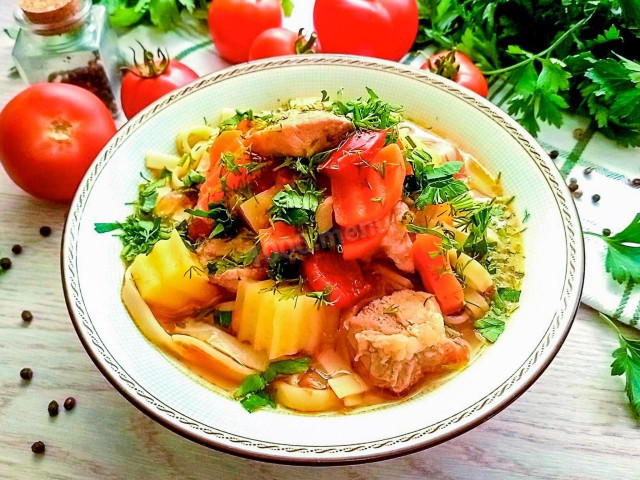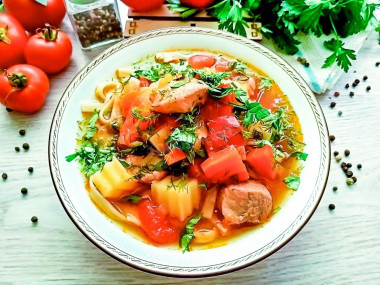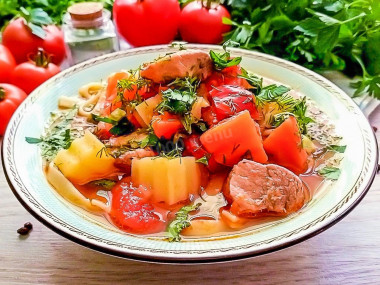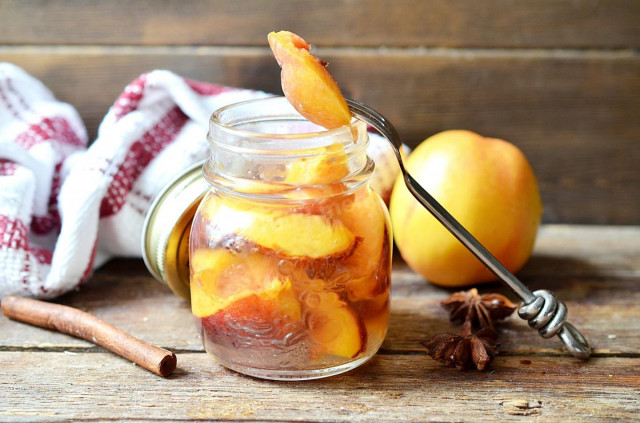Composition / ingredients
Step-by-step cooking
Step 1:

How to cook pork lagman with potatoes and noodles? Prepare the necessary products. For soup, you can take any part of pork, I have a part of ham. You can also replace pork with any other meat according to your preferences. Be sure to take purified water. Tap water can give an unpleasant taste. Vegetables are suitable for fresh, seasonal. Take noodles from durum wheat, you can replace it with spaghetti. And it's better to cook homemade gourmet noodles.
Step 2:
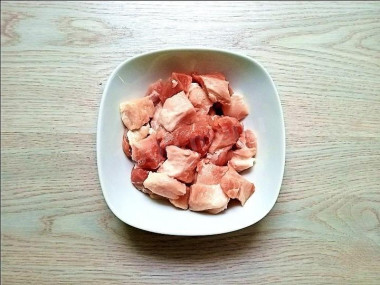
First, rinse the piece of meat that you will use in running water. Dry it with a paper towel, cut off all the films and cut into medium pieces.
Step 3:
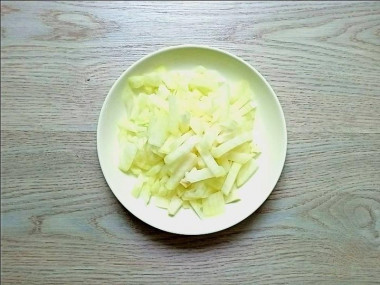
Peel the onion, rinse and cut into small cubes. In order not to sting your eyes during slicing, rinse the onion slices and the knife under running water.
Step 4:
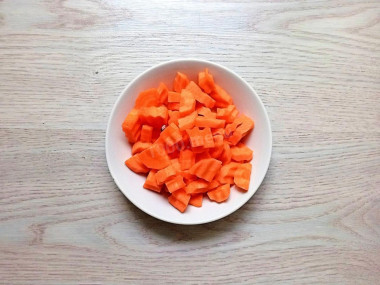
Wash the carrots with a brush from dirt, peel them with a knife or a vegetable peeler. Cut the carrots lengthwise into four pieces, and then cut into medium pieces. I used a curly knife.
Step 5:

Wash the Bulgarian pepper and free it from the stalk with seeds. Cut it into strips lengthwise and then into squares. Pepper can be taken in any color, but red will give more colors to the soup. I took green and red.
Step 6:
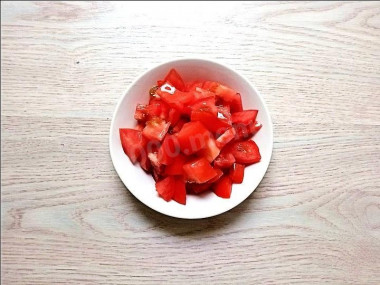
Wash the tomatoes, remove the stalk and cut into arbitrary pieces, it is better to fit the rest of the vegetables for greater harmony. If you do not like skins in a tomato, then make an incision on it cross by cross and scald with boiling water. The skin will easily come off.
Step 7:
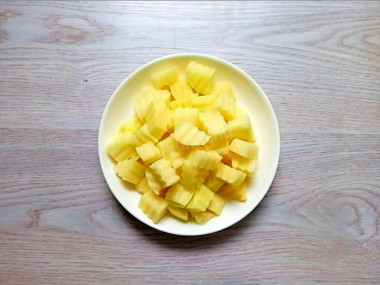
Wash the potatoes from dirt with a brush, peel and cut into medium cubes. Or you can cut into larger pieces to your taste. I made a cut with a curly knife.
Step 8:
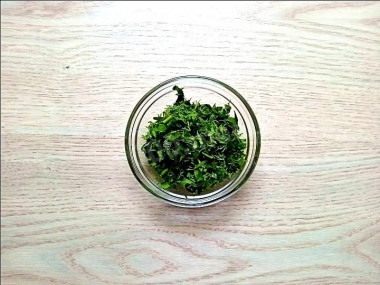
Rinse the greens under running water, dry with a paper towel and finely chop. You can take any greens to your taste: dill, parsley, cilantro, celery or basil.
Step 9:
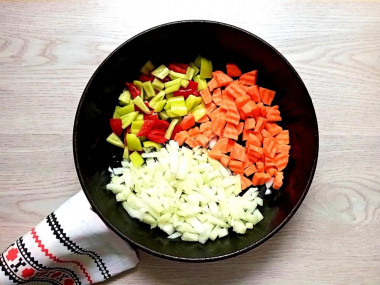
Take a deep frying pan, lubricate the bottom and sides with odorless vegetable oil. Put the onion, carrot and bell pepper. Fry for about 5-7 minutes on medium heat until the vegetables are soft.
Step 10:
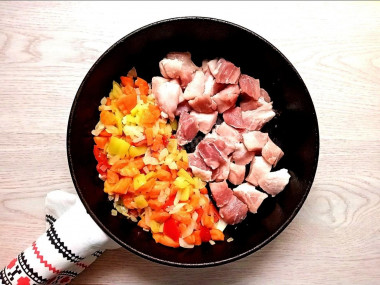
Slide the vegetables to the side. Put the chopped meat in a frying pan and fry it until lightly browned. Then mix the meat and vegetables, add salt and pepper to taste.
Step 11:
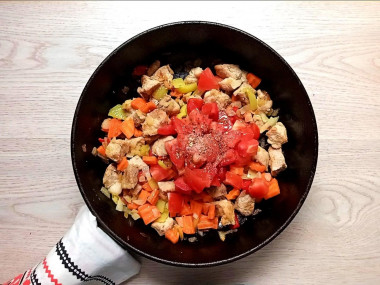
Add tomatoes to the pan, stir and simmer for about 5 more minutes.
Step 12:

Add tomato paste and 250 ml of hot water to the fried vegetables and meat. I do not advise using cold water, it will reduce the overall temperature and the dish will cook longer. The saturation of the gravy depends on the amount of tomato paste. Tomato paste can be replaced with tomato sauce or ketchup. Simmer the gravy for 30 minutes over low heat.
Step 13:

Transfer the contents of the frying pan to a saucepan, add the potatoes to it and mix.
Step 14:
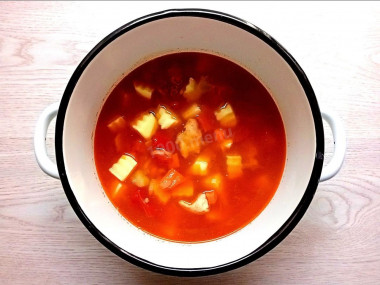
Pour filtered water into the pan, adjusting the density you need. I added a liter of water and I got a pretty thick soup. You can take less water and you will get a thicker gravy. Bring the dish to a boil and simmer for another 30 minutes on low heat. Cover the pan with a lid, but not completely, so that steam comes out.
Step 15:
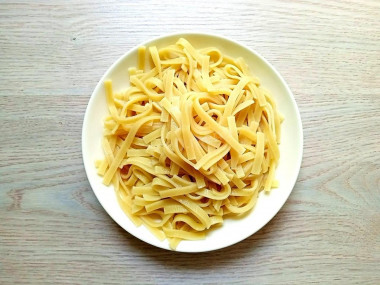
At this time, boil the noodles for lagman. To do this, pour 2 liters of filtered water into a separate saucepan and add a tablespoon of sunflower oil. This will help the noodles not stick together. Bring the water to a boil and add salt. Put the noodles in boiling water and cook for about 5 minutes until half cooked. Focus on the softness of the noodles. It should not be hard, but also not quite soft. Discard the noodles in a colander or sieve.
Step 16:

When serving, put noodles in a deep dish and pour it with gravy with vegetables and meat. If the noodles have cooled down, pour boiling water over them. Sprinkle liberally with fragrant herbs on top and serve to the table. Bon appetit!
Traditional noodles are an invariable component of the classic lagman. And meat and vegetables can be replaced to your taste. As a meat ingredient used: lamb, beef, horse meat. In European cuisine, lagman is also cooked on pork, chicken and turkey.
Vegetables are also added very different in season and taste: daikon, radish, eggplant, celery.
You can see the best recipe for homemade noodles for lagman
here
.
Important! Regardless of whether the amount of water for soup is indicated in the recipe or not, it is best to focus on your own preferences (thick or more liquid soup you like), as well as on the size of your pan and the products taken for cooking. Do not forget that the author has his own view on the amount of meat, potatoes, cereals and other ingredients in the soup, which may not coincide with yours. In practice, this means that if you are cooking for the first time, you should not cook a whole pot at once. Make a soup for tasting - for one or two people. To do this, reduce the amount of all ingredients according to the recipe to 1-2 servings, and take the amount of water from the calculation: from one cup per serving - if the soup is very thick, to 1.5-2 cups - if more liquid. Do not forget to take into account that part of the liquid will boil off during the cooking process. After tasting a small portion of soup, you can adjust both the amount of liquid and the proportions of ingredients to your taste. In the future, like most experienced housewives, you will be able to pour water for soup and lay the ingredients “by eye".
For cooking, it is better to use filtered or bottled water that is neutral to taste. If you use tap water, keep in mind that it can give the dish an unpleasant characteristic taste.
Any oils are useful only until a certain temperature is reached - the point of smoking, at which the oil begins to burn and toxic substances, including carcinogens, are formed in it. How to determine the roasting temperature and choose the best oil for frying, and which is better not to use at all, read here .
Caloric content of the products possible in the composition of the dish
- Ripe potatoes - 80 kcal/100g
- Baked potatoes - 70 kcal/100g
- Mashed potatoes - 380 kcal/100g
- Boiled potatoes - 82 kcal/100g
- Potatoes in uniform - 74 kcal/100g
- Fried potatoes - 192 kcal/100g
- Tomatoes - 23 kcal/100g
- Pork fat - 333 kcal/100g
- Pork meat - 357 kcal/100g
- Pork - low-fat roast - 184 kcal/100g
- Pork chop on a bone - 537 kcal/100g
- Pork - schnitzel - 352 kcal/100g
- Pork Shoulder - 593 kcal/100g
- Boar's leg - 113 kcal/100g
- Pork - 259 kcal/100g
- Sweet pepper - 27 kcal/100g
- Carrots - 33 kcal/100g
- Dried carrots - 275 kcal/100g
- Boiled carrots - 25 kcal/100g
- Ground black pepper - 255 kcal/100g
- Vegetable oil - 873 kcal/100g
- Tomato paste - 28 kcal/100g
- Salt - 0 kcal/100g
- Noodles - 135 kcal/100g
- Water - 0 kcal/100g
- Onion - 41 kcal/100g
- Fresh frozen soup greens in a package - 41 kcal/100g
- Greenery - 41 kcal/100g

